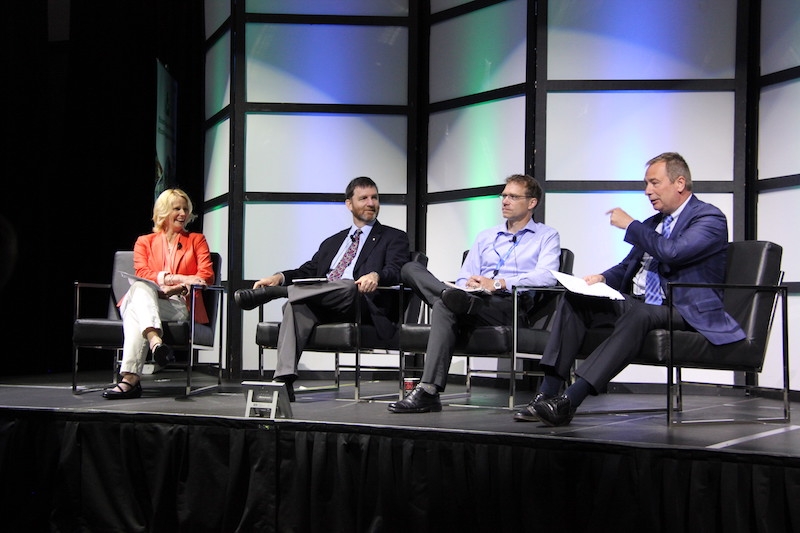
News
Energy Summit 2018: Optimizing compressed air, ISO 50001 and other energy management strategies
While smart technologies and buildings can help large and small power consumers alike save energy, this year’s Energy Summit focused on energy management solutions, best practices, leadership and innovation.
August 14, 2018 By Ellen Cools
 Stream chairs Dianne Zimmerman
Stream chairs Dianne Zimmerman Energy Summit 2018 brought together many of Canada’s energy efficiency experts to help over 400 delegates learn how energy management systems can improve profitability and how some companies are leading and innovating in energy usage, as well as to share practical solutions for facilities.
The summit was presented by the Canadian Industry Partnership for Energy Conservation (CIPEC), the Excellence in Manufacturing Consortium (EMC, emccanada.org) and Natural Resources Canada (NRCan). Energy Manager was also there, serving as both media partner and reporter.
Our focus was to attend sessions that were not just informative (they all were!), but whose topics could also increase your own knowledge of the energy landscape and, thereby, guide your efforts toward the development of new revenue streams.
Compressed air: “The fourth utility”
Before the sessions began on Day 1, the educational stream chairs discussed which sessions they were most looking forward to. Best practices stream chair David Arkell, president and CEO of 360 Energy (and regular columnist for Energy Manager), shared his enthusiasm for the session, “Energy savings through compressed air.”
“One of the biggest opportunities in energy management is compressors,” Arkell explained.
Once I heard that, I knew I needed to attend the session and share the insights with Energy Manager readers.
The session itself consisted of four presentations, but it was the first — “Compressed Air Systems…wasting energy since the start of the Industrial Revolution,” by Jeff Scott, key accounts and outreach manager for Enwin Utilities — that caught my attention.
“Compressors can represent one of the largest energy consumers in industrial facilities,” Scott began. Indeed, they represent 40 to 50 per cent of electricity costs in a facility.
Compressed air is a poorly utilized and misunderstood system, with units often relegated to the “deepest, darkest locations of a facility.” Consequently, they are often “out of sight and out of mind,” he continued.
And although facility managers can easily forget about compressors, they are still a significant drain on financials. In fact, over the life of a compressor system, a facility will spend more than the cost of the compressor itself on electricity, service and operations, said Scott.
With that in mind, the first thing to understand when it comes to compressors is it does not pay to buy the cheapest one.
There are two distinct systems when it comes to compressors: the supply side, which includes the compressors themselves, storage, air quality equipment and controls, and the demand side, which includes the distribution system, secondary storage and end-use equipment.
Scott focused his presentation largely on energy-saving solutions on the supply side. One of these is using properly sized equipment to address your facility’s needs, as an oversized compressor will prove costly.
Moreover, because there is rarely a flat demand for compressed air, sequencing multiple compressors can save energy and reduce costs. Cascading pressure bins overinflate the system, whereas sequences and master controllers ensure compressors are only operating when needed.
Another one of the easiest energy-saving solutions is preventative maintenance.
“A lot of people don’t think about maintenance in terms of energy savings,” Scott explained. But motors have to work harder to draw the same volume of air through a plugged-up compressor as they would through a well-maintained one.
In a similar vein, leaks are a huge energy drain. The typical system suffers 15 to 25 per cent air leakage. Fixing leaks normally results in a simple payback of less than six months. To address the issue, leak management must be an ongoing process, Scott said.
Finally, most of the energy used for compressed air systems is lost to heat. As such, heat recovery is vital to improve efficiency. Installing heat recovery systems, such as space heaters or a heat exchanger, will result in both efficient energy use and savings.
Scott concluded his presentation with a number of possible action items for energy managers, including baselining, calculating energy use and costs, identifying areas to reduce bottlenecks and pressure levels, identifying and fixing leaks and finding other ways to reduce costs and improve performance.
He also provided a number of resources for energy professionals, including the Compressed Air Challenge, the Compressed Air and Gas Institute (CAGI) and a number of compressed air service providers.
ISO 50001: How big is the gap?
In the last session of Day 1, BC Hydro industrial marketing manager Kevin Wallace gave a presentation called “Bridging the gap between Strategic Energy Management and ISO 50001.”
Wallace noted that ISO 50001-2011, “Energy management systems – Requirements with guidance for use,” has been rather polarizing; essentially, there are those for the global standard and those against it. In his presentation, Wallace aimed to quantify the gap between Strategic Energy Management (SEM) and ISO 50001, such as gap size and location, and determine whether becoming ISO 50001-certified really requires that much more work.
First, we have to understand the minimum elements of SEM:
• Customer commitment (from a utility perspective) regarding energy policy and resources.
• Planning and implementation.
• Monitoring, tracking and reporting.
According to Wallace, ISO 50001 fits into the definition of SEM. He provided a number of case studies (and a detailed report for each) identifying the gaps between their energy management systems and ISO 50001.
One case study looked at Canfor’s Northwood Pulp Mill in Prince George, B.C., which — based on the gap analysis — had to carry out 155 hours of work (roughly four weeks) before it could earn ISO 50001 certification.
In his analysis, Wallace looked at a number of components, including energy policy, performance indicators, general implementation, planning and training. He highlighted the biggest gaps in the Northwood Mill example for Energy Summit delegates, then did the same for a few other case studies to give us a better understanding of the differences between ISO 50001 and SEM.
He also highlighted the Focus on Energy SEM Leaders Program from Energy Performance Services (EPS/Canada, pivot.vc/eps), a consulting firm that implements energy management systems, including ISO 50001 procedures, for commercial and industrial companies.
In this case study, Wallace said, EPS worked with 14 organizations to develop energy management programs, providing cohort events, one-on-one coaching and direct support and performing individual ISO 50001/Energy Management Information System (EMIS) audits at each site early in the process.
The companies’ overall starting score, on average, met about 20 per cent of ISO 50001’s requirements, but today, “half of them have completed ISO 50001 and three are ISO-ready,” Wallace said.
Overall, to close the gap between ISO 50001 and other energy management systems, Wallace suggests looking to the Consortium for Energy Efficiency (CEE, cee1.org) for guidance on SEM, whether for you or your customer’s companies. He also suggests implementing an EMIS.
Alternatively, you can look into NRCan’s ISO 50001 program, which helps companies move toward certification, or even the U.S. Department of Energy’s (DOE’s) ISO 50001-Ready program, which sports an aggregator tool that can be useful in identifying gaps.
3 pillars of successful energy management
Also in the last session of Day 1, Andrew Hejnar, energy manager for 3M Canada, gave a presentation on his company’s energy management strategy.
The company’s goals with this strategy were to mitigate the impact of increasing energy costs while enhancing its competitive position and company reputation, Hejnar explained.
The strategy rests on three pillars: (a) metering and targeting, (b) technology and projects and (c) people. Hejnar outlined how these pillars helped reduce 3M’s energy use and how the same strategy could be applied in other facilities.
SEE ALSO How has 3M Canada cut energy use by 32%?
When it comes to metering and targeting, “What you can’t measure, you can’t control,” he said. “Make the energy visible.” This can be done through sub-metering or an energy map, for example.
Metering and targeting provide real-time information for operating personnel and energy consumption reporting for management, which influences tracking and budgeting, Hejnar said. These factors help establish energy baselines and targets.
Meanwhile, there are a few key technologies for reducing energy use that 3M focused on: combined heat and power (CHP), LED lighting, compressed air optimization, HVAC and heat recovery.
While such technology plays a key role in lowering energy costs, the third pillar, people, is the most important, Hejnar argued, because it’s a company’s employees who operate the equipment and consume energy.
Integrating them into the energy management system through programs such as energy conservation awareness campaigns, training and an employee suggestion program, as 3M did, lets employees know they matter, Hejnar explained.
Above all, Hejnar advised, “You have to have management commitment.”
Indeed, with its own management commitment, 3M has transitioned to an enterprise model.
This has increased their visibility to customers and lowered its implementation costs. Additionally, “when you have an enterprise system, the number of external audits you have to do is calculated. There is a very significant time, commitment and cost reduction because there are fewer audits,” Hejnar explained.
Overall, 3M’s energy management strategy has saved the company a total of $15 million from 2008 to 2018.
Benchmarking with RETScreen
The Energy Summit came full circle for me on Day 2, when I attended a session demonstrating RETScreen clean energy management software, which is also used by 3M Canada.
In fact, the company was the first in the country to use the software, according to Greg Leng, who created RETScreen at NRCan’s CanmetEnergy research centre in Varennes, Que.
3M’s success with the software led to its global deployment, Leng said, and the company now uses RETScreen as part of its ISO 50001 certification.
The software allows energy managers to perform analyses for multiple types of facilities, including industrial, residential and agricultural, Leng explained, and can be used in both new construction and retrofit installations.
RETScreen Expert, the most recent version, includes a feasibility analysis module, energy auditing and more. It can be used for small and large facilities and is free to download.
It also gives energy managers the opportunity to perform benchmarking analyses that go beyond simply telling you your facility’s consumption level. The software also provides the reasons behind that consumption and how to improve upon it.
Additionally, RETScreen features a performance tracker that lets you know if you’re constantly saving. Climate data is also provided to help with analysis.
Most interesting to me was how RETScreen facilitates energy modeling. This feature allows managers to predict how much they could save through different energy-efficient measures.
Currently, many companies look for simple payback, but “simple payback is the death of most cost-effective energy projects,” Leng said.
Instead, with RETScreen Expert, energy managers can perform a financial risk assessment to determine if projects are cost-effective.
During the actual demonstration of the software, the energy experts in attendance were captivated; it was clear to me that RETScreen would be a useful tool for all energy managers. There are still some improvements that need to be made, such as including industrial plants, mining companies and other facilities in the energy modeling module, it clearly has massive potential.
Overall, Leng argued, RETScreen is a tool that helps the industry “take that step to make analysis more sophisticated.”
Conclusion
Whatever your Canadian jurisdiction, the more you know about energy management strategies, best practices, technologies and the like, the more you can bring to the table. Attending events like the Energy Summit can help you stay up-to-date on the latest innovations, collaborate with other energy experts and ultimately come away with knowledge that will help you better manage your organization’s energy use.
Print this page
